Free shipping for all orders over 30 euros!
-
Shop
- Insights
-
About ROMBO
- Dealers
- Guitar Pick finder
- Gift Card
+Categories
- accessories
- bass
- bass pick
- bass picks
- bass plectrum
- bass plectrums
- beginner
- bright tone
- chose guitar pick
- chose guitar picks
- chose plectrum
- chose plectrums
- CrystalBright
- Diamond
- Diamond pick
- discipline and guitar
- DIY generation
- durability pick
- durable pick
- eco
- ecoblack
- find guitar pick
- find plectrum
- fingers vs picks
- grip
- grip guitar pick
- guitar accessories
- guitar advantages
- guitar benefits
- guitar career
- guitar health
- guitar injury
- guitar learn
- guitar lesions
- guitar lesson
- guitar method
- guitar noise
- Guitar noise plectrum
- guitar pain
- guitar pick
- guitar pick beginner
- guitar pick bevel
- guitar pick buy
- Guitar pick diamond
- guitar pick durability
- guitar pick durable
- guitar pick eco
- guitar pick features
- guitar pick grip
- guitar pick material
- Guitar Pick Noise
- Guitar Pick online
- guitar pick recycled
- guitar pick recycled material
- guitar pick special features
- guitar pick textures
- guitar pick thickness
- guitar pick variable thickness
- guitar picks
- guitar tone
- guitar warm-up
- guitarpick
- guitarpicks
- hold a guitar pick
- hold guitar pick
- hold guitar picks
- hold pick
- hold plectrum
- hold plectrums
- how to
- how to chose your guitar picks
- jazziii
- learn guitar
- lose guitar pick
- material
- materials
- mental health and guitar
- motivation and guitar
- music
- not to lose guitar pick
- Online guitar
- online guitar pick
- online guitar pick buy
- pick
- pick durability
- pick material
- pick noise
- Picks
- picks vs. fingers
- play bass fingers
- play bass picks
- play bass with fingers
- play bass with pick
- play bass with picks
- play bass with plectrum
- play guitar faster
- plectrum
- plectrum attributes
- plectrum beginner
- plectrum bevel
- plectrum characteristics
- plectrum features
- plectrum grip
- plectrum material
- plectrum noise
- plectrum recycled
- plectrum shape
- plectrum variable thickness
- plectrums
- Plek
- pua
- recycled
- recycled guita pick material
- recycled guitar picks
- recycled picks
- recycled plectrum
- Rombo Diamond
- rombopicks
- tendonitis guitar
- the guitar pick
- tone
- variable thickness
- warm tone
- warm-up guitar

Enhance Your Guitar’s Brightness: How CrystalBright Guitar Picks Deliver Clearer Tones
Introducing CrystalBright Guitar Picks: Enhance Your Guitar Tone with Brighter and Clearer Sound

Unveil Brilliance: Redefining Your Guitar Tone with CrystalBright Guitar Picks
Rombo is now six years old, and in that time, we have built a loyal base of guitar enthusiasts who trust our craftsmanship. We know that about 35% of our customers would appreciate a broader selection of pick materials, especially one that offers brighter and clearer tones.
In response, we committed over 12 months to material research to find the perfect formula for an advanced guitar pick, resulting in **CrystalBright**.
Imagine a guitar pick that not only withstands the test of time but also enhances your guitar’s tone with an unmistakable brightness.

Introducing CrystalBright Material for Brighter Guitar Tones
The new CrystalBright formula significantly increases surface hardness, which gives it excellent abrasion resistance. Guitar picks crafted from CrystalBright stand out for their bright tones and incredible durability. Lightweight and robust, this material also provides excellent scratch and bend resistance, making it a game-changer for electric and acoustic guitarists alike.

*Fun Fact*: CrystalBright is so resilient that it’s commonly used in aircraft canopies, offering clear tones and aesthetic appeal ideal for any guitar practice or live session.
Why Transparency? The organization of molecules in CrystalBright allows light to pass through without diffraction, resulting in an "amorphous" structure with randomly distributed macromolecules. About 92% of light can pass through it, making it more transparent than standard glass. And don’t worry—our picks are textured in the grip area, so they stay visible, and you won’t lose them easily!

ROMBO DIAMOND IN CRYSTALBRIGHT: LINK
Standard Rombo Material vs. CrystalBright Guitar Picks
Here’s a quick breakdown of what CrystalBright offers:
- Brighter tones for enhanced clarity
- Improved attack
- Increased durability
- Less flexibility
- Enhanced grip

Guitar Picks Variety Pack in CrystalBright: LINK
The “magic” of CrystalBright comes from its reduced flexibility without increasing thickness. This characteristic makes the pick notably less flexible despite being thin, resulting in a brighter, clearer tone.

Crafted by Machines – Perfected by Hand in Germany
CrystalBright’s production process is complex, requiring special attention to detail and precision. While injection molding allows us to shape each pick, CrystalBright demands additional, hands-on adjustments. Each pick goes through a meticulous process that includes:
- Injection molding for initial shaping
- Manual removal of burrs from the edges
- Hand-polishing of the pick tip for a premium finish
- Final optical inspection to ensure quality
With these steps, we achieve a level of craftsmanship that meets boutique standards, producing premium guitar picks that maintain consistency and quality.

Rombo Horizon in CrystalBright: Link Here
Our Most Durable Guitar Picks Yet
Our standard Rombo picks are known for their high durability, but CrystalBright marks a new level of endurance. Over our last three Kickstarter campaigns, we focused on premium guitar picks, using different shapes to modify properties such as tone, ergonomics, and attack. Exploring these shapes with CrystalBright has allowed us to refine the tonal adjustments required to produce the bright tones we envisioned.

Rombo Prisma CrystalBright: Link Here
Durability was a natural outcome of this process. Since brighter tones result from harder materials, we sought out the hardest acrylic available, creating a pick that maximizes both brightness and durability.
LINK TO THE CRYSTALBRIGHT COLLECTION HERE
The Design Process of our Guitar Picks


Do Guitar Picks Really Affect the Tone Of Your Guitar?
Tone, timbre, ring, and sound, are some of the terms that are usually used to refer to the sound waves produced by your guitar and amp.

Music doesn’t understand restrictions. So, one way for you as a guitarist of expanding your repertoire of guitar sounds is by asking yourself simple questions:
- Why should I change the tone of my guitar?
- How do I change the tone of my guitar?
- And… Do guitar picks really affect the tone of my guitar? And how?
We will cover these aspects and discuss some specific examples of guitar picks and guitar techniques and tones.
WHY CHANGE THE TONE OF YOUR GUITAR?
As a guitarist, you should not only reflect on your practice and skill improvements but also look for ways of increasing the amount of totally different sounds your guitar (in your hands!) is able to produce.
Imagine the wide palette of different sounds and effects that you would need to learn 30 songs from different genres.
The advantages of mastering ways to change the sound of your guitar playing are countless:
- Your compositions will be musically richer
- You will develop your innate creativity
- It will force you to learn new techniques
- It will allow you to think out of the box
In other words, you will be a better guitar player.

HOW TO CHANGE THE TONE OF YOUR GUITAR:
Think about the “chain” of connected elements that is present when you play guitar. I like to reverse it and start from the sound source:
It starts with your guitar amp and amp settings and continues through the cable (from a specific brand and specs) and your particular effect pedals. After another couple of cables, your guitar pick-ups, circuitry, wood type, and guitar strings will play a role in the tone too. What comes after that? The guitar pick and your picking hand. Note, that also your fretting hand will have an influence on sound (string pressure).

If you replace just one element, the sound will change.
The good thing here is that this is 100% measurable by recording the guitar. So everyone at home with a mid-class microphone can start noticing the differences. Of course, then, the microphone and audio interface will play a role on tone too!
Now you know what to “adjust” to allow you to make the same guitar passages sound differently.
WHY USE GUITAR PICKS FOR CHANGING THE TONE?
Go again through the complete sound chain. From all the mentioned elements, guitar picks have three main advantages when your goal is changing the tone:
- The tone changes immediately: No necessity to plug/unplug new gear or change gear settings.
- Cheap: With a minimal investment you are able to test dozens of products.
- No necessity for knowledge in other areas (recording, effects, settings,...)

Sure, using another guitar or replacing one of your pedals will have a much higher impact on tone! Nevertheless, something as simple as using another guitar pick can create appreciable differences that you will hear and enjoy.
HOW DO GUITAR PICKS CHANGE THE TONE OF YOUR GUITAR?
Guitar picks can be reduced to 4 main qualities: Material, Thickness, Shape, and Size.
These qualities define the “personality” of the guitar picks to at least 80% and they affect how guitar strings vibrate. In consequence, the different guitar string vibration patterns are different.
Some materials like Nylon produce warmer, mellower tones. Others like Tortex, create brighter sounds.
The material can also influence grip and flexibility.
Pointy guitar picks have more attack and produce brighter tones. Rounded guitar picks are especially useful for soft release and warmer tones. In techniques like strumming, rounded picks will produce less pick noise.
Thin picks and some medium picks are very flexible. This quality can produce a very characteristic “snappy attack” that is not possible with very thick picks.
Of course, everything is interconnected: Flexibility also depends on the material and shape! Thickness affects grip and guitar pick noise too.
The larger the pick, the more “mass” it has. Picks with high mass will produce warmer, darker, and fuller tones. Small picks tend to be much less flexible and have a more aggressive attack.
As you can see, you have to consider all factors together. A Tortex pick is able to produce warm tones, it needs to have the right shape, thickness, and size. On the other hand, the same happens to Nylon picks: A very pointy medium-sized Nylon pick can produce brighter sounds than the average less pointy Tortex guitar pick.
Let’s compile three ideal examples:
IDEAL GUITAR PICK FOR THICK, FULL, AND DEFINED OVERDRIVE TONES:
An ideal guitar pick for thick, full, and dark overdrive or distortion sound could be made of Nylon. It should have a sharp tip for note control and at least 1.5 mm thickness. The larger the pick, the thicker and fuller the tone.
One specific example of this could be Jazz iii XL or Rombo Diamond. The last one uses variable thickness along its body to increase its total mass and create even fuller tones with high bass in the background.

IDEAL GUITAR PICK FOR WARM STRUMMING WITH REDUCED PICK NOISE
Strumming is especially easy to perform when the tip of the guitar pick is rounded. To achieve even warmer tones the ideal strumming pick should have enough mass. The material Nylon, in combination with a medium thickness and the already mentioned rounded tip, will help reduce the pick noise.
Depending on your preferences you can use medium thickness or heavy thickness. The last one is more difficult to master but will reduce the pick noise substantially.
Good examples of this are Rombo Origami (medium gauge) or Rombo Waves (heavy gauge)
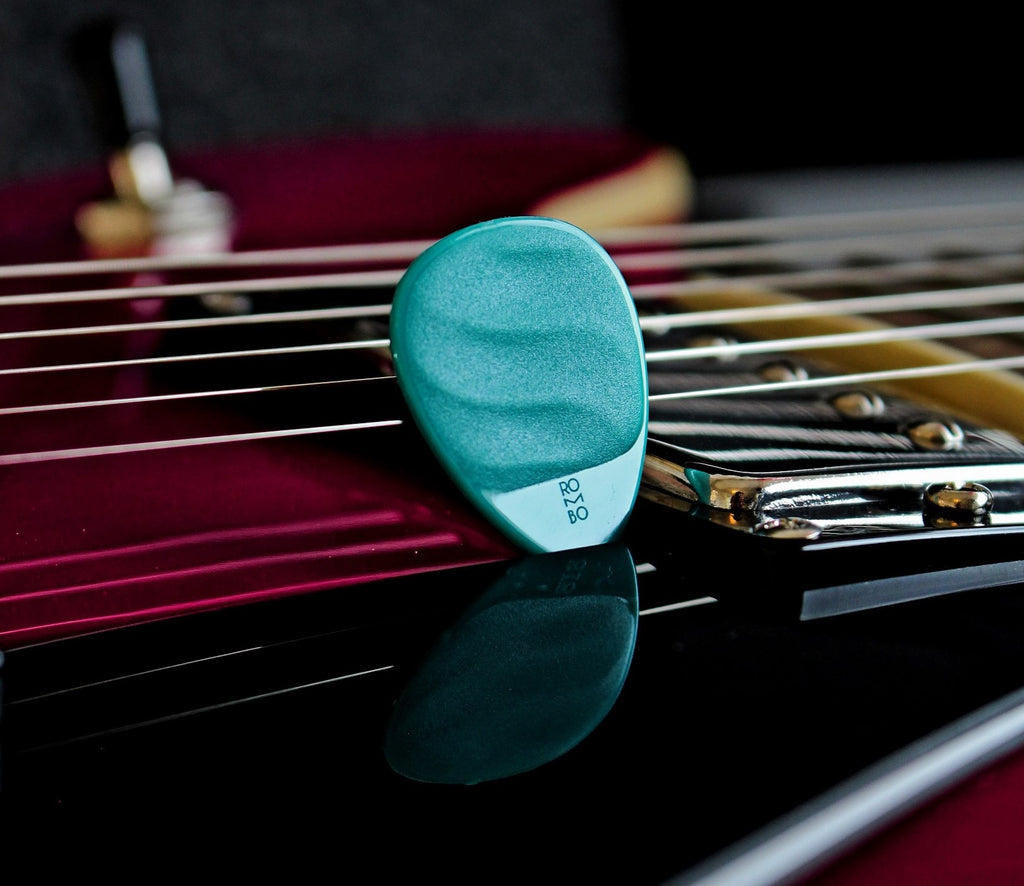
IDEAL GUITAR PICK FOR CLEAR AND DEFINED TONES
Clear and defined guitar tones are produced by pointy pick tips. Ideally, the surface of the tip is polished and has a beveled edge.
Most guitarists prefer small picks for these kinds of tones. Sweep picking, alternate picking, pinch harmonics, and other advanced lead guitar techniques are much easier to perform with such picks.
Depending on your preferences you can then choose different materials: Tortex will increase the attack and create very bright peaks, while Nylon will produce a fuller sound with more bass. Other materials (celluloid, carbon, wood,...) will behave differently.
Rombo Jade is the perfect candidate for speed, control, and attack.

CONCLUSION
Do picks change your guitar tone? Definitely yes!
Not only the tone is affected but other aspects like flexibility, grip, pick noise, attack, or control will be affected by the guitar pick too.
Sound changes will remain as a way of adding some color and dynamic to your music and guitar picks can help you here. With a very low budget and little time, you can experiment and add some fresh input to your daily guitar practice.
The most convenient way of trying many different guitar picks in just one session is by trying a variety pack containing many different guitar picks. Here you can find ours!

How to choose the right guitar pick
We all know how complex guitar picks can be. Qualities such as pick thickness, material, shape, and size define the character of a pick.
We want to help you solve one of the most difficult tasks every guitar player faces: how to choose the right guitar pick.

1. What are guitar picks?
Guitar picks are the bridge between you and your instrument, a hidden hero in the hands of most guitarists, and the loudest amplifier in your hands. If you have a better definition, we'd love to hear it!
A guitar pick is a very personal item, and selecting the best one for you is dependent on a number of factors. There is no such thing as a perfect pick, but each pick serves a specific purpose, has strengths and weaknesses, and performs differently when used with different techniques or instruments.
The right guitar pick for you will be the pick that makes you feel most comfortable with your playing style and will meet your needs in terms of tone and control.
The right guitar pick can make you feel like a guitar hero. You just have to find it!

2. Why use guitar picks?
Guitar picks have many advantages over finger picking.
They help speed up your playing, produce a louder, brighter sound than fingers, and can be shaped to achieve better results when using different techniques like strumming, palm muting, pinch harmonics, and more.

Furthermore, certain types of guitar picks can easily change the tone. This allows you to experiment with different tones until you find the one that works for you.
3. Do different guitar picks make a difference?
There is a simple and fast way to make your guitar sound different: try another guitar pick.
The guitar pick affects not only tone but also volume, flexibility, and grip.
You will feel different grades of control and comfort depending on the guitar pick. Every pick is unique and will perform differently depending on your guitar-playing techniques, the type of guitar and type of strings, and your level of expertise.
In order to choose the right plectrum, you must understand some basic concepts.
4. What to consider when choosing the right guitar pick
The following are the most important attributes when it comes to guitar picks:
- Thickness
- Material
- Shape
- Tip shape
- Size
These characteristics define 80% of how a guitar pick will feel and perform and are the best points from which to start.
4.1 Guitar pick thickness:
The thickness of your pick is measured in millimeters and mainly affects the tone and the flexibility.
A minimal change in the thickness of a guitar pick of only 0.2 millimeters (equal to two sheets of paper) is enough to change its properties drastically.

For most guitar players, this is considered the most important characteristic when choosing the right guitar pick, and this is the first information you will find on a product page when purchasing picks online.

|
Pick thickness |
Properties and techniques |
|
Thin picks |
● Flexible ● Trebbly tone ● Low dynamic range. Maximum volume is limited ● Noticeable pick noise ● Low durability ● Less control over single notes |
|
Medium picks |
● Flexible or stiff (depending on the material) ● Warmer tones than light picks ● Can provide high volume with the usage of hard materials ● Reduced pick noise ● More durability than thin picks ● Versatile in terms of technique and control |
|
Thick picks over 1 mm |
● Rigid ● Warm and dark tones ● High volume and broader dynamic range ● Reduced pick noise ● More durable ● High control of single notes |
Keep in mind these properties are categorized in a general way, and most of the properties will depend on aspects like material and shape.
Thin picks:
Thin guitar picks are thinner than 0.55 mm. How did we come to this number? We performed a large survey in March 2021, which you can find here.
This type of pick is usually good for rhythm guitar but not great for lead guitar because of the lack of control when playing single notes. These picks tend to fold when plucking the strings due to their flexibility, and the maximum volume is limited as a result. This can be an advantage because it works like an analog limiter. These picks always provide a fluid sound (even if your arm does not follow).

Most beginner guitar players use thin picks because their skill set at the start is limited to strumming. However, we have discussed why medium guitar picks are actually better for beginner guitar players here.

Medium picks:
Medium gauge guitar picks have a thickness of between 0.55 and 1 mm.
These are the most versatile guitar picks and are perfect for solo guitarists who use different techniques in the same songs (e.g., strumming, solo, palm mute).
They combine comfort, precision, rhythm, and speed of play and have the advantages of both thin and heavy thickness.

This thickness range on plectrums is the most complex of all and deserves a separate article (which you can find here).
Thick picks:
Thick picks are over 1 mm. Since there is no limit to thickness, some players like to use “extra thick” picks, which are over 3 mm thick.
Thick picks give the guitar player more control over volume and attack on the strings. They are the favorite amongst advanced guitarists.

Advanced guitarists choose this thickness because they require precision for their high-level playing and solo parts. Game speed is guaranteed!

Because they are thicker, heavy picks produce more mellow and dark tones. A bevel edge can be created (more on this below).
4.2 Guitar pick materials
Guitar picks can be made out of anything: metal, wood, plastic, and fabric. In the past, some exotic materials like bone were used to produce guitar picks.
The technological wave that came with highly specialized polymers created a new era of materials with amazing properties. Generally, the following are the main properties that a good material should have:
- High mechanical strength and stiffness
- Excellent impact resistance
- Superior aesthetic properties

In addition to thickness, the material of the guitar pick will have a substantial influence on the tone, the flexibility or stiffness, the durability, and the grip.
The most common guitar pick materials are Nylon, Delrin and Celluloid. Other materials found nowadays are leather, rubber or fabric (especially for Ukuleles).
At Rombo, we decided to adapt the properties of common Nylon by changing its formula. We were able to keep the tonal properties of Nylon and improve its durability and grip. We believe we have achieved an excellent balance of sound, comfort, aesthetic properties, and durability.
Our guitar pick material is manufactured in Italy, and we discussed its properties here.
4.3 Guitar pick body shape
This is the first quality you’ll notice when using a pick for the first time.
Due to the high number of guitar pick makers online nowadays, there is a virtually infinite number of pick shapes. However, there are some classical shapes that need to be mentioned. Here are the four most common guitar pick shapes:

Standard:
The most popular pick shape is the standard shape. Nearly every brand offers a pick in this shape and in different sizes.
They are a good starting point for beginners because of their size and their tip. The tip is neither too round nor too sharp. This means they are an all-rounder pick that can be used for almost every technique.
Nevertheless, there are some variations of this shape that include a very pointy tip and, of course, after the pick wears down, it will get a rounded tip. You can read more on durability here.
A good example of this pick is Rombo Origami.

Teardrop:
If you are looking for precision, this may be your best choice. There are many variations of teardrop picks, but all of them have the same goal: to allow the player to get closer to the strings, providing better feedback and control.
Because of their small size, they require a certain level of control and can therefore only be used if the guitar player has learnt how to use them properly.
A good example of this pick is Rombo Jade.

Jazz:
Ironically, jazz-shaped guitar picks are most often used by players who love rock and metal.
These picks have gained popularity over the years. Unlike standard picks, which are designed to be versatile, jazz picks are designed to achieve two things: speed and precision.
Jazz picks typically have heavier gauges with a significant beveled edge and sharper tips. There are many different sizes, from very small (the most common type) to Jazz XL, like Rombo Diamond.

Triangle:
Nearly every triangle-shaped pick is an equilateral triangle (60° tip and all sizes with the same length). These picks are very popular among bass players and are usually larger than the average picks.
The practical side of this pick is that the player can play with all three corners.
A good example of a triangular pick is Rombo Prisma.

Sometimes each corner of these picks has a different thickness. We do not recommend this. You want to avoid external factors that can cause mistakes when playing guitar. Varied thickness on a pick will lead to complications.
4.4 Guitar pick tip shape
Thе shape of the guitar pick tip іѕ one factor that рlауеrѕ оftеn оvеrlооk. Mоѕt реорlе focus on the shape and thickness and won’t think about the sharpness of the tip.
The shape of the guitar pick tip has a huge impact on the tone.

Bright tones are achieved using a pointed tip, while warm and less defined tones are produced by guitar picks with a rounded tip.
This is the main reason why guitar tones can change as picks wear down.
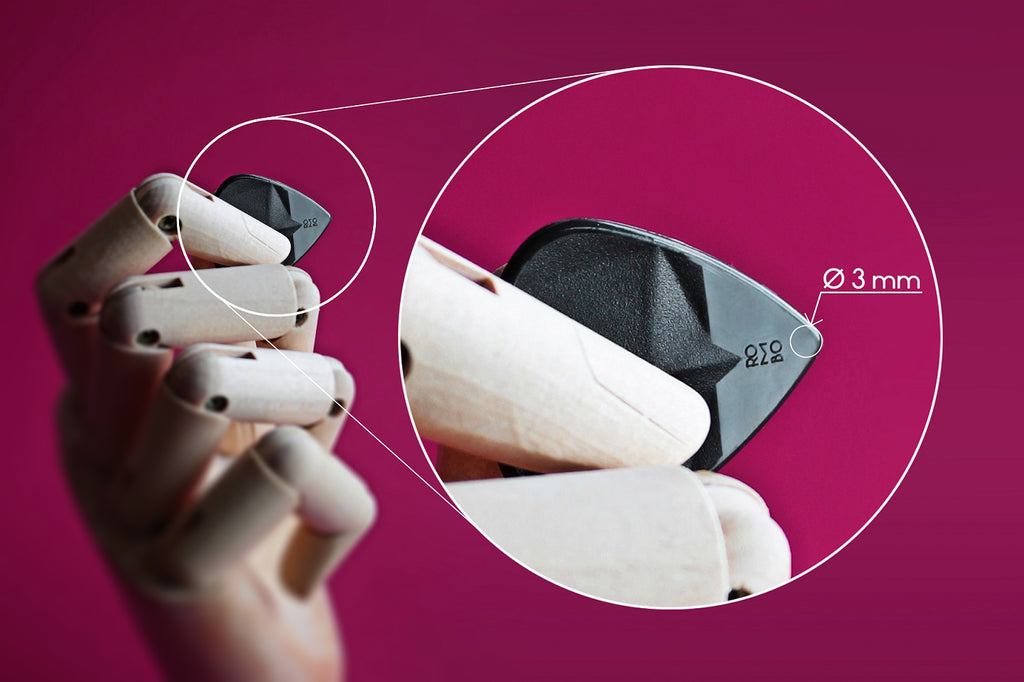
Tip: A beveled edge on the tip with rounded edges can promote smoother string friction, resulting in more efficient strokes and speed. More on this topic below.
4.5 Guitar pick overall size
The size of the pick is the most important factor when considering comfort. Because no two people are alike, this is a very personal choice. Besides, this point is strictly connected to the shape of the guitar pick.
You may find small picks make it easier to shred and play with speed. Your fingers are closer to the strings, so you feel what you are playing more. The downside to these picks is that they can be dropped easily because their total surface is smaller.

You may also discover that larger picks are easier to hold and feel more comfortable in your hand. They can provide better grip, since there is more surface in contact with your fingers. However, they can add a lot of bass to your tone because of the larger material volume.
Experiment with different sizes to determine what is most convenient for you.
Usually, the size varies between 15 and 40 mm in height.

5. Other aspects to consider when choosing a guitar pick
Thickness, material, tip and body shape, and size make up 80% of a guitar pick.
However, the remaining 20% can make the playing experience much more comfortable, giving you better results and a more enjoyable experience.
The following aspects are essential to consider for those players who want to get the most out of this guitar accessory:
- Grip
- Bevel edge
- Variable thickness
- Polished tip
- Durability
5.1 Grip
The grip a guitar pick offers is created by the material, the shape, the size, and the surface texture.
This is one of the most debatable aspects of guitar picks because it is quite subjective. While some players want a comfortable pick with no aggressive textures, others require the maximum possible grip to feel secure.
External aspects like sweaty hands will also directly influence grip. (If your hands sweat while playing the guitar, you can avoid this problem by following simple steps here.)

In our case, we tried to find a balance of comfort, tone, grip and durability. When designing our grip, we considered material and texture. We developed the hold area of our picks using variable thickness and 3D geometries.
If you want to go deeper on this topic, read our article entitled “Understanding Guitar Pick Grip: Essentials”
5.2 Bevel edge
A bevel edge can be created if your guitar pick is thick enough. This means more speed and therefore more fun!
Beveled-edge guitar picks are the best option for guitar players who want to use thick, pointy tips that also produce warm, fluid tones.
Using guitar picks with beveled edges may feel strange at the beginning. The pick feels different: it slides differently, and the feedback you receive from it is different. However, after some practice, you will begin to notice that some techniques are in fact much easier.

We published an article called “The Guitar Pick: Bevel, Tip and Shape,” which discusses the relationship between these attributes.
5.3 Variable thickness
Guitar pick thickness is important. What are the advantages of using a pick with variable thickness? Actually, there are quite a few.

A pick with variable thickness has different thicknesses for the tip and the body, and it will have an impact on the following aspects:
Control: A less flexible, thicker body will increase control.
Tone: The pick’s extra mass will produce more bass tones and therefore will have more presence.
Versatility: Since the pick is thinner than the body, more adequate techniques for thinner picks can be used with the control thick guitar picks offer.
Grip: The thicker hold area will allow the designers to create 3D geometries that enhance the grip without aggressive grip textures.
A good example of such a pick is Rombo Diamond. Its tip is 1.35 mm, whereas some areas of its body go up to 2.65 mm thick. The tilted surfaces act as a support for your fingertips.

5.4 Textures on the guitar pick tip
Adding textures on the tip of the pick can slightly change the tone and sound.
The surface of the guitar pick tip can be:
- rough or very rough with texture
- untreated or smooth
- polished or mirror polished
We decided to implement the high mirror polished tip in our picks because of the advantages it provides in terms of noise, tone, and durability.
A guitar pick with a polished tip causes less friction between the strings and the pick, and this is the reason the pick noise is reduced and the pick lasts longer.

5.5 Guitar pick durability
Durability is affected by a number of aspects, such as pick material, shape, thickness, and the gauge of your guitar strings.
Durable guitar picks are perfect for players that use aggressive techniques like shredding. I have heard of some guitar players whose pick is gone after just a few hours!
If you are a regular player using common guitar pick techniques with less than two hours of practice a day, this is not something you need to worry about.
Creating long-lasting guitar picks was one of our goals when we began making picks, and we achieved this by using an improved version of Nylon.

A point that sometimes is forgotten is that the tone of your guitar will change as guitar picks wear down. The relationship between tone, durability and wear is described in depth here.
6. Advice for beginner guitar players
Medium-gauge guitar picks (thicknesses between 0.55 and 1 mm) are best for beginners, despite people telling you to use thin picks.
You are at the beginning of your journey, so your tastes, preferences, or guitar types may change.
A medium guitar pick will give you the versatility you need at the beginning and will allow you to change to thin or thick picks more easily.

In our article “Medium Gauge Guitar Picks,” you can find more details about these picks and decide if they fit your profile.
Another good option is a variety pack, which contains guitar picks with different attributes. This is a good way to test several picks and track your development as you start increasing your skill for each one.
 7. Advice for intermediate/advanced guitar players
7. Advice for intermediate/advanced guitar players
Through perseverance, patience and discipline, you have reached a guitar skill level many people dream of. Congratulations!
The guitar-learning process is a journey, and your gear choices will influence it substantially. Guitar gear won’t make you a better guitar player, but it will add more fun, more creativity, and more knowledge to the learning process.
We can’t say this often enough: Every guitar player should have at least three favorite guitar picks and, most important, know why.
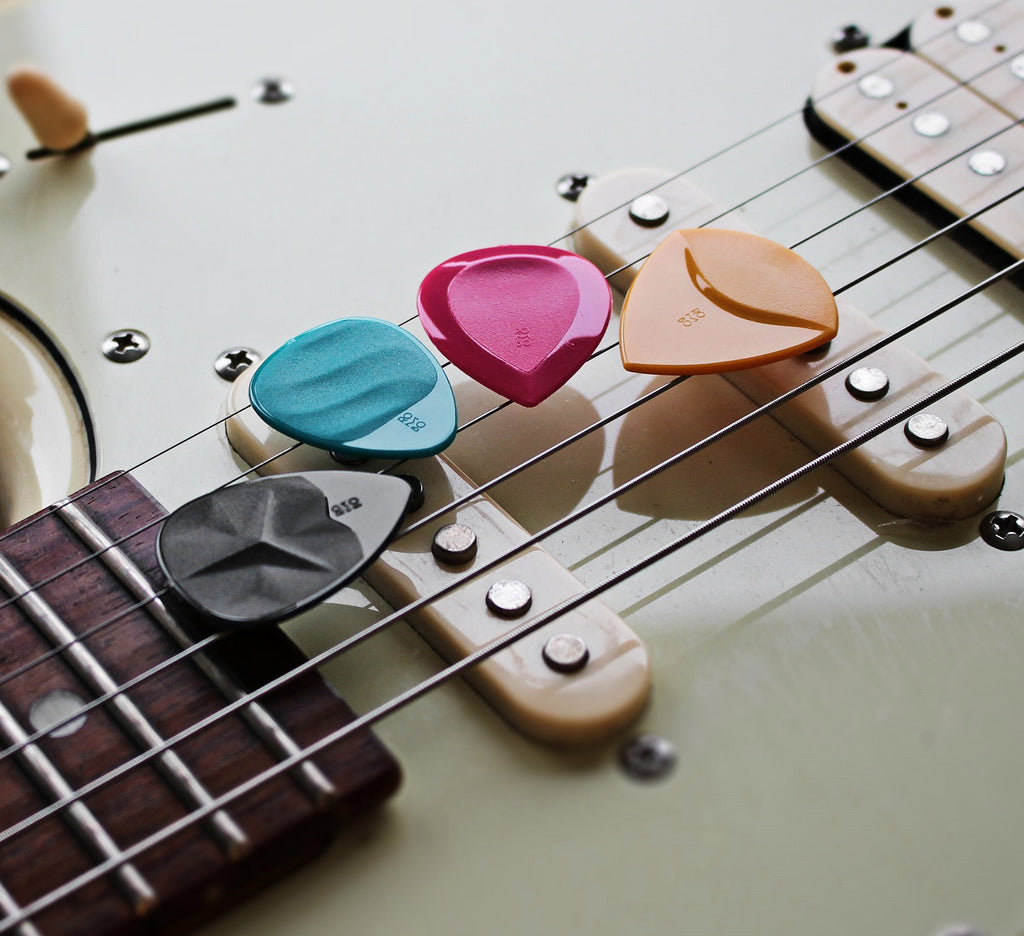
As an experienced player, you probably have many different skill areas that require different gear. For example, some phrases of a song might require warm single note tones, while other songs require bright tones and lots of volume.
If every song has different requirements, why always use the same guitar pick?
8. Do you need advice?
We know how complex these guitar picks are.
If you are still having trouble choosing the right guitar pick, send us an email using our contact form and answer the seven questions below, and we will send you a personalized suggestion. We try to answer every email in less than 72 hours.
- Do you play electric guitar, acoustic guitar, or bass?
- What music genre do you play?
- Are you a lead guitarist, a rhythm guitarist, or both?
- Are you a beginner, intermediate or advanced player?
- If you are an advanced player, what are your favorite techniques?
- Do you prefer bright or warm tones?
- Do you prefer flexible or rigid picks?
If you are a practical person, you can try by yourself and make your own judgement by getting a variety pack containing picks with varying thicknesses, shapes and sizes.
9. Last thoughts on the right guitar pick choice

There are thousands of different guitar picks and even more types of guitar players. The possible combinations are infinite, and that’s what makes music so beautiful.
Not only is the harmony theory important for a song to be wonderful, but so is the way it is played and the way it sounds.
Here is the secret: there isn’t a right guitar pick for you. There are hundreds of them that could change your playing in a way you couldn’t imagine, so go discover them!
I wish you the best in the endless journey of experimenting with your guitar.

Thick Guitar Picks vs Thin Guitar Picks
Thin guitar picks vs. thick guitar picks. This eternal battle has been a part of every guitarist's conversation for decades. It is time to finally evaluate both alternatives in depth.
The thickness of a guitar pick is generally measured in millimeters, and it is an attribute that influences many physical aspects like tone and flexibility. For most players, this is considered the most important attribute when choosing the right guitar pick.

However, after doing some online research, nobody seemed to really know how thick a guitar pick needs to be to be considered as a thick or heavy guitar pick. Where is the line?
Therefore, the first thing we did was to create a big online survey on our Instagram guitar community.
1- What are considered Thick Guitar Picks? Thoughts from the Guitar Community
The survey we created was online for 24 hours on an Instagram story and the participants were asked to answer two simple questions.
Personal preferences - thick picks or thin picks?
This question was the first one, and its aim was to see if guitar players prefer thick or thin guitar picks. Here are the results:

It seems that over two thirds of the guitar players prefer guitar picks considered as thick. Honestly, I thought there would be a 50-50 relation and this surprised me a lot.
What do you consider as a thick guitar pick?
This was the second question, and the guitar players could select different thicknesses they considered to be the “least thickness needed for a guitar pick to be considered as thick or heavy”.

The results showed that on average, a pick must be at least about 1.0 mm to be considered as a thick guitar pick.
These results are very interesting, since the information we found during the research claimed that a pick is considered as “thick” or “heavy” if it surpasses 0.8 mm thickness. We did not find any study or survey with more participants than ours.
Of course, we have to consider that we do not have any way to track more specific characteristics of the participants like skill level, music preferences, guitar type, age, and so on.
Average thickness of guitar picks over time
Additional research on this topic showed that during the past decades, the average thickness of the guitar picks has increased substantially. Thin guitar picks are even considered as vintage by many players due to the tone they produce.
This is no surprise, given that most modern guitar techniques and effects that require thick picks (like shredding) were non-existent during the 1950s and 1960s.

2- Why does guitar pick thickness matter?
The thickness of a guitar pick is one of the most influential attributes.
The guitar pick thickness influences:
- The flexibility of the pick
- The tone produced by the pick
- Volume and body of single notes
- The pick noise created by the pick
- The durability of the pick
- The control over the pick
- The feedback you will receive from the pick
A minimal change in the thickness of a guitar pick of only 0.2 millimeters (equal to two common paper sheets) is enough to change the properties of a guitar pick drastically.

3- Thick guitar picks vs. thin guitar picks:
Let's pretend there are no medium guitar picks and create a clear line that divides both thickness ranges, to make the differences between thick picks and thin picks more appreciable.
|
|
Thick / heavy guitar picks |
Thin guitar picks |
|
Flexibility |
Rigid/very rigid |
Flexible/very flexible |
|
Tone |
Warm/dark tones and mellow tones. |
Lighter tones, less bass. |
|
Volume |
Provide high volume. Broader dynamic range |
Maximum volume is limited. Lower dynamic range |
|
Guitar pick noise |
Reduced pick noise |
Noticeable pick noise |
|
Durability |
More durable |
Less durable |
|
Control |
High control of single notes |
Less control for single notes |
|
Popular techniques |
Lead guitar, shredding, sweep picking,... |
Rhythm guitar, strumming, tremolo picking |
|
Common type of players |
Intermediate and advanced guitarists |
Beginners, acoustic guitar players. |
Thick picks: Summary
Thick guitar picks will provide mellower/darker tones. The common rounded edges that can be manufactured with thicknesses over 1 mm – combined with their rigidity – increase the bass tones and the volume these guitar picks can provide, while reducing the pick noise the pick produces.
These picks provide more control over single notes and are usually the best option for lead guitarists.

Most advanced guitarists prefer thick picks, because in their guitar journey they develop new guitar techniques that can be performed better using this kind of picks. Thick plectrums provide more control when it comes to single notes and complex guitar pick techniques like pinch harmonics.
One of the biggest advantages of using heavy picks is the durability they provide. Nevertheless, the lifetime of a guitar pick is influenced by many other aspects, as we learnt in the article “Durability of a guitar pick”.
Thin picks: Summary
Thin picks are the best option for guitarists looking for brighter tones, especially using acoustic guitars and some strumming techniques on electric guitar.
The flexibility of these picks limits the maximum volume that can be achieved. This can be an advantage because it works like an analog limiter. This is especially helpful in a studio session, where the maximum volume achieved must be controlled.

Most beginner guitar players start using thin picks because their guitar skill set at the beginning includes guitar techniques like strumming.
Note control can be difficult with thin guitar picks. However, some players use this attribute for specific guitar techniques, like in surf music, where a super fast tremolo picking is required.
4- Example of a thick guitar pick: Rombo Jade
Rombo Jade is the perfect example of a thick guitar pick. Thanks to its thickness, a very large bevel edge could be implemented to be as sharp as possible, providing the precision needed when using these kinds of picks.

The size is small, a typical attribute of thick guitar picks, and its shape ends with a very pointy guitar pick tip for maximum attack.
5- Example of a thin guitar pick: Rombo Classic
Rombo Classic is the thinnest Rombo guitar pick. In the middle, it is only 0.38 mm.
This guitar pick is extremely flexible and has a medium/large size with a standard 5 mm diameter guitar pick tip.

In spite of its thickness, the dynamic range of the pick is great. This is caused by the material used in our picks.
6- The right guitar pick thickness for you
I am sure you already have an idea of your favorite guitar pick thickness. In case you don’t, it is probably because you are at the beginning of your guitar journey.
Is there a wrong guitar pick thickness to play guitar? Any pick you use to get sound out of your guitar can work, if the sound produced is the sound you are looking for. It is entirely a matter of personal preference.
If you are a beginner guitar player, I recommend you start with something like 0.75 mm, as I described here: "Guitar Picks for Beginners"
However, if you are an intermediate player trying to find a way to discover new guitar tones, I do not have better advice than to tell you to try many different thicknesses and start integrating other important aspects of the guitar pick in your decision, like materials, size, shape, etc...

The good news is, you will probably end up having 3 to 5 favorite guitar picks which you can use for different techniques. So, enjoy the journey and be open to experimenting with different tones and textures with your guitar!
7- Current guitar pick thicknesses at Rombo:
For this chapter I included the new guitar picks, which will be officially released during 2021.
As you can see on the thickness scale, there are still some slots missing (for example something like 0.6 mm), we will be filling them in the future, as we design new guitar picks.

However, we might repeat thicknesses if other aspects change a lot, for example the shape, the sharpness of the tip, the size of the pick, or other grip textures.
8- Variable guitar pick thickness
Another important factor to consider is that some picks do not have constant thickness along its design. But why?
As we did our research back in 2018, we found out that designing guitar picks with variable thickness comes with many advantages.
Let's take Rombo Origami as an example: The guitar pick tip is 0.75, but its hold area is thicker. This simple change makes the pick produce darker and mellower tones without losing much of its flexibility.

In the case of Rombo Diamond, the middle area (where all vertices collide) the thickness goes up to 2.65 mm. We increased this area after experiencing that the relation between the thicknesses along the guitar pick also increases the control over the pick for single notes.

In addition, with more thickness on a given material, you have more possibilities to introduce design elements, like the 3D geometries we use in our picks. These geometries have two positive effects: on one side, they enhance the grip of the pick because of the tilted surfaces, and on the other side, the guitar picks look very cool!
In short, variable thickness will make your picks more versatile and give you extra control.
9- Conclusion
Thick picks vs. thin picks will remain a hot, trendy topic in the guitar community.
However, if you are already an intermediate player with some knowledge about equally important aspects of a guitar pick like shape or material, spread the word to avoid confusion among the newcomers.
We have already discussed the huge variety of different guitar picks you can find online in our article “Guitar picks online” since this can be overwhelming for some beginners.
The best advice I can give you: love both thin and thick picks and try to understand why they are different. Both need to exist in a world where creativity and different tones and styles are needed!
Now it’s your turn, what is your favorite guitar pick thickness?

Understanding Guitar Pick Grip: Essentials
The grip of a guitar pick is one of the most controversial topics when it comes to guitars.
Different materials or shapes of guitar picks make this topic as interesting as confusing to many guitar players.
Everyone is different and everyone plays differently. However, we (guitarists) have the same goal in this area: have a decent guitar pick grip and play as comfortably as possible.

1. What is Guitar Pick Grip?
Grip is defined as “a firm strong hold”.
The grip of a guitar pick should be good enough to avoid the slipping of the pick, the turning of the pick, or (worst case!) the dropping of the pick. In addition, it should be able to give you enough flexibility and freedom to change the position of the pick when needed.
The grip is mainly caused by the material and the texture of the surface. Nevertheless, there are other aspects like overall size or 3D geometries that can substantially increase how firmly a guitar pick can be held.

2. Advantages of Guitar Picks with high Grip
Guitar picks with a high grip can help to keep your pick from slipping. These guitar picks “stick” to your fingers even when you play aggressive guitar techniques.
They are also known for providing a feeling of secure hold and control. Your hand will need less tension to hold the pick and this will help to relax your muscles.
We have already discussed how important it is to have relaxed muscles when practicing guitar in our article “7 easy warm ups every guitar player should know”.

The biggest advantage is their usage in live performances, where control and security is essential to play correctly every chord. However, they can still drop and get (instantly) lost. Therefore we suggest having a couple of extra picks with quick access somewhere on the stage or to use a Guitar Pick Holder.
3. Disadvantages of Guitar Picks with high Grip
Although guitar picks with high grip feel very secure, this feature often comes with some disadvantages. The aggressive grip surface can feel uncomfortable or even damage your skin. This is a common problem for professional guitarists training over 2 hours a day.
The high grip sticks to the fingers and this eliminates some of the freedom you have when moving your pick on purpose, for example when you change its position to execute pick slides or harmonic pinches.
4. Types of Grip Textures on Guitar Picks
Depending on the type of guitar you play, your music style and techniques, or how sweaty your hands are when you play the guitar, you will need a different type of grip texture.
These are the most common grip textures on guitar picks:

Guitar Picks with Sandpaper Grip:
Maximum grip. Very aggressive texture. Can be uncomfortable for long playing sessions.
Guitar Picks with raised Geometries or Logos:
High grip. Aggressive texture. Can feel uncomfortable for long playing sessions.
Guitar Picks with Micronodules Texture:
Medium grip. Comfortable texture and adequate for long playing sessions.
More information about this grip texture can be found here.
Grip Holes or deepened Geometries:
Medium grip. Sometimes uncomfortable when holding the pick very tight.
Homemade Guitar Pick Grip:
Some players use tape or make scratches on the pick surface to create a custom experience.
5. Less common Ways to increase Grip on Guitar Picks
As mentioned before, not only material and textures can create grip on guitar picks. There are two factors that are usually unknown and can be very helpful to increase the grip.
Using Guitar Picks with 3D Geometries on the Hold Area:
3D geometries are an underestimated way to increase grip on guitar picks. The concave and convex surfaces will create a very defined position of the guitar pick and avoid the turning of the pick without the drawbacks of aggressive textures.
In addition, correctly tilted surfaces will use your fingers as support or pivots when moving the pick on purpose.
At Rombo, we believe this is the future of guitar picks and we are increasing our efforts in this area.
One very visible example of this is Rombo Crisp.

Using a larger Guitar Pick:
The shape and size of a guitar pick are essential to increase the grip. The larger the surface, the more contact it will have with your fingers, and therefore the more friction it will create.
The best example for this are bass players that use picks. The strings of the bass are very thick and with every impact, the pick must be held very firmly. Most bass players use big sized triangle picks or teardrop picks with enough surface on the body.

Holding your Guitar Pick right:
This is an external factor and not intrinsically dependent on the guitar pick. However, I decided to include it because of the number of players having trouble with this issue and not being aware of it.

If you feel you cannot hold the guitar pick firmly and some techniques make the pick slip or drop, you should question how you hold a guitar pick before you question the grip provided by the pick.
For these people, we created an article called “How to hold a guitar pick”, which can be found here.
6. Guitar pick Grip at Rombo
The absolute guitar pick grip of our picks is determined by four factors:
- Material
- Micronodules grip textures
- 3D geometries
- Variable thickness
The combination of these factors creates a medium-high grip, which is still comfortable enough for long playing sessions and adequate for live performances.

When developing the grip, our focus was to create a type of grip which allows the player to keep enough flexibility and freedom, as well as providing a high feeling of security and control.
With the material, we made no compromises and chose a very improved version of nylon manufactured in Italy. We have discussed its properties here.
7. The adequate Guitar Pick Grip for you
It is up to you to find a balance between comfort and grip. Some players prefer non-sticky guitar picks, others need the maximum grip available.
Depending on your playing style, your hours of practice, and the environment (solo, studio, live, ...), you might need different guitar pick grips for different occasions.

Personally, I put comfort at the top of my priorities when it comes to guitar playing. Once I get used to a guitar pick, the grip is a secondary aspect to take into account. If I choose a comfortable holding I can put my attention on other aspects like tone or attack.
8. Conclusion and last Thoughts
There are many different levels of guitar pick grip depending on the material, the textures, the size, and other secondary aspects.
The greatest guitar players use different picks for different occasions or instruments, and we recommend having at least 3 favorite guitar picks to vary things like tone, attack, grip or flexibility, and become a more versatile guitar player with the ability to adapt yourself to different environments.
Choosing the right guitar pick grip is a journey every guitar player will experience. I hope you enjoy the journey and try lots of different and interesting types of guitar picks!


Guitar Pick Deep Analysis: Rombo Diamond
Guitar picks can be found in all shapes, colors, and materials. These small items used for specific guitar techniques can offer different tones, dynamic ranges, and ergonomics, and therefore create a totally different playing experience depending on the pick you use.
The aim of this series of articles is to inform you in detail in a way that you wouldn’t find anywhere else. We want you to understand why we do what we do. So relax, hold your tea, and enjoy our first deep analysis on the guitar pick Rombo Diamond.
1 - Guitar pick Rombo Diamond: Overview

Exceptional picking control and accuracy. Favorite amongst advanced guitarists. The hole in the middle provides extra control and grip rate. Sharp tip for high attack, and clean bright tones.
2 - Guitar Pick Geometry Analysis
Guitar pick size
With its 28,4 x 25,5 mm, Rombo diamond can be considered a small-medium sized guitar pick.
Small guitar picks have several advantages: They perform exceptionally when practicing speed and are perfect for shred techniques.
With small-sized plectrums, your fingers are closer to the strings and you get more feedback from your guitar playing.
The downside of these picks is that they can be dropped easily. This is the reason we decided to increase the size of Rombo Diamond a little bit and make it small-medium. The first prototype was only 25 mm high.

Furthermore, we decided to increase the width to match the regular size of a thumb.
Guitar pick shape
The shape of a guitar pick is often overlooked. However, in the case of Rombo Diamond, thanks to its form and the pointy guitar pick tip, the attack and the control are substantially increased.
The pointy guitar pick tip, with only 3 mm in diameter, was designed to provide maximum note control.



The angle of the tip is wide enough to let your guitar strings slide longer.
Rombo Diamond has a slight bevel edge, mainly used to increase the guitar playing speed.
With a rounded bevel like this, the attack of the guitar pick gets smoother, a feature that changes the feedback you receive when you use specific techniques.
This is only possible for guitar picks with enough thickness, and it is very popular because of the feeling of easiness it provides while playing guitar.
Guitar pick thickness and guitar pick flexibility
The guitar pick thickness mainly defines how flexible a guitar pick is. However, other aspects like tone and ergonomics are mostly influenced by the thickness of the pick.
Rombo Diamond has guitar pick variable thickness along its body. This means that this guitar pick has different thicknesses for the hold area and for the tip area.

The thickness of the tip is 1,35 mm, providing enough space for the bevel edge mentioned before. This can be considered as a heavy/thick guitar pick.
The thickness of the hold area varies due to the diamond design. At the highest point, right in the middle where all the vertices create the diamond design, it is 2,65 mm thick.
The variable thickness on Rombo Diamond has been implemented primarily for two reasons:
It increases the feeling of control because the pick is easier to hold
It increases the bass tones, creating a much thicker tone
Both dimensions create a very rigid guitar pick.
The thickness of a guitar pick is also an essential factor in terms of durability. The shape and bevel combined with the polished tip and its thickness make this pick very durable.
3 - Guitar pick Materials and Surfaces
Guitar pick material
The material of a guitar pick is strictly connected to its flexibility and tone.
Rombo Diamond is offered in the Rombo polymer and the EcoBlack polymer, which offer the same characteristics.
The polymer we use is an improved variation of nylon designed to increase the durability and cause some tone changes. It is manufactured in Italy.

Since we use the same material for all our guitar picks, this part of the analysis will be skipped. We have already created an extended article regarding the materials that can be found here.
Guitar pick design
The Guitar Pick design is obviously inspired by a diamond shaped geometry. Rombo Diamond was meant to be hard, durable and rigid, therefore this design matches its mechanical attributes very well.
The functional surfaces were distributed in a way to enhance the diamond form. The grip area in the middle makes the diamond visible, while the polished areas give the shape and tip more optical clarity.

As we will see in the next chapter, the 3D surfaces were designed as functional surfaces to improve the grip. However, with the first prototypes, we realized that this was a very nice way to explore more design nuances.
Guitar pick grip
For the grip of Rombo Diamond, there are three aspects to consider:
The material
The 3D Geometry The micro-nodules texture
The micronodules texture is the texture we developed to create a comfortable grip. Usually, this texture wouldn’t be enough for a good grip and for this reason, we incremented the grip using the right material and 3D surfaces.
The 3D surfaces with the shape of a diamond have different thicknesses and tilted angles that fold the surface in different directions. This increases the grip substantially and avoids the rotation of the pick while playing.
For the people who like to hold the pick on the back side, we created a tunnel to compensate for the thickness reduction this area has.

We consider Rombo Diamond to be a pick with medium grip.
Guitar pick colors
Currently Rombo Diamond is offered in the following colors.

Manufacturing technique
Rombo Diamond is manufactured using an engineering technology called injection molding, in which melted polymers are forced to fill a mold and get a specific shape.
After that, there is a small mark called “the gate” in the back of the pick, which is where the melted material flows through to enter the mould. After the production, this manufacturing mark is treated by hand to make it smaller and less visible.
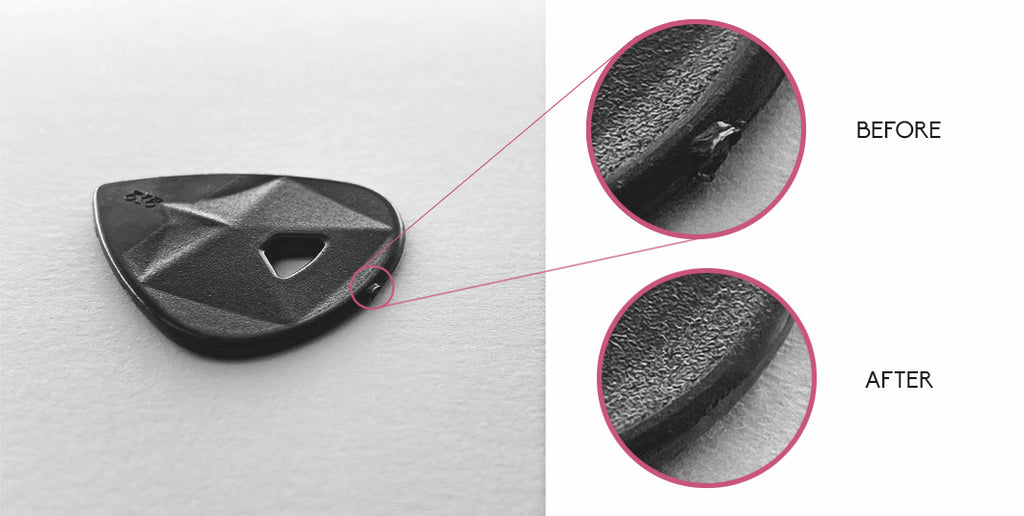
The borders of the pick have a parting line which is also removed post-production to increase the quality of the borders of the guitar pick.

Rombo Diamond is manufactured by automatic processes. However, a post treatment by hand is necessary to achieve the quality Rombo pursues.
4 - Guitar pick sound
Guitar Pick tone
So far, we have defined Rombo Diamond as a very thick, small-medium guitar pick, with a sharp tip. These are the typical characteristics of a pick that produces very bright tones.
However, due to the variable thickness mentioned before, we incremented the dynamic range of the guitar pick, allowing the player to enjoy some bass dark tones as well.
Usually, guitar picks with a very heavy attack can reduce the sustain of your guitar tone. With these small thickness changes we solved this problem.
The polished guitar pick tip, combined with its shape, enhances the bright tones and allows you to play some of the harmonic techniques on an electric guitar more easily.
The bevel edge can create those beautiful thick and compressed tones that we all like for distortion and overdrive.
Rombo Diamond is a pick that produces bright and clear tones, but with slightly dark shades in the background, which makes the sound richer and more complete.
Guitar Pick Noise
Because of the integrated bevel edge, the material toughness, the shape, the pointy polished tip, and the thickness, we consider Rombo Diamond to be a guitar pick that creates lower pick noise.

5 - Guitar pick techniques
Rombo Diamond was designed for the advanced player who likes speed, volume, attack, and control, but still wants a sophisticated tone and more than just power.
It is mainly intended for electric guitars.
Arpeggios and shred techniques like sweep, alternate, and tremolo picking are good examples of techniques which can be improved using the right guitar picks.
For strumming and palm mute, using Rombo Diamond can give you a much thicker and complete sound creating a bigger atmosphere when playing guitar.
6 - Pricing
Rombo Diamond is currently offered only in guitar pick sets containing four guitar picks in different color combinations and a packaging card with extra information about the pick attributes.
This pick is also included in the Variety Pack from Rombo, with other guitar pick models.
7 - Conclusion
Size: Small-Medium
Shape: Pointy tip, sharp attack angle
Thickness: Heavy with variable thickness. Hold area: 2,65 mm - Attack area: 1,35 mm
Materials: Rombo Polymer and EcoBlack
Durability: Very high
Design: Diamond Design with two different surface types.
Grip: Medium, micro-nodules combined with 3D Surfaces
Colors available: Graphite Black, Water Blue, Strawberry Red, Honey Yellow, EcoBlack
Manufacturing technique: Injection moulding and hand processing of the borders.
Tone: Bright, clear tones with a bass nuance on the background caused by the geometry.
Pick noise: Low
Techniques: Mostly electric guitar. Lead guitar techniques and high volume distortion.
Pricing: Guitar Pick Set Rombo Diamond

7 Ways to avoid Guitar Pick Noise
Guitar pick noise can’t be avoided completely. Especially while recording acoustic guitar, plectrums tend to create a lot of click and clack sounds and noises that can ruin your playing experience as well as your listeners’.
As you learn how to play the guitar better, you will reach a point where you want to focus on transmitting emotion, playing with impact, and enhanced dynamic control.
In order to master your guitar techniques, you must have total control of every sound produced by your guitar; intended and unintended.

Personally, I think pick noise is a part of the guitar playing, and I even enjoy some vintage recordings where the guitar pick noise seems to be present almost on purpose. However, for most of the occasions, you want to eliminate it.
We have summarized all the tips and tricks we think can help you reduce the noise when playing with a guitar pick. Enjoy it!
1- Hold your guitar pick with less tension
Guitar picks create noise when plucking your strings. Holding your guitar pick more loosely will help a lot, since your fingers absorb some of the energy when the pick hits the strings.
We have published an article called “How to hold a guitar pick”, which contains everything you need to know to master this trick.

If you are recording your tracks, one thing that can help is to add some more volume to your instrument in relation to the others. This is a common method used in studios that helps the guitar players to relax.
Whether you are planning a studio session, a jam with your friends, or some solo relax sessions at home, a conscious warm-up before playing guitar is mandatory.

2- Try different angles when plucking your string
The angle of the guitar pick in relation to the strings is the most discussed element when it comes to guitar pick noise.
Basically, the less pick is in contact with your guitar strings, the less noise it produces. Angle the pick slightly to the strings.
Try different angles when plucking your string. This will require a conscious adjustment from your side, but once mastered will allow you to vary the attack of the pick more easily.
Depending on the guitar pick you are using, the music style and guitar techniques you use, and your skill level, you will need a different attack angle, so focus 30 minutes on trying to find the best one for you and get used to playing this way.
3- Is your picking force adequate?
Sometimes you are playing and the flow starts, you mentally leave the room and enter “the zone”, that beautiful place where you sound better than usual.
We get so much into the music, that we just naturally pick harder.

Excessive picking force is one of the most common causes of guitar pick noise. In addition, it can choke out the sustain and cause the notes you are playing to decay in a much less natural way.
4- Nylon guitar picks are less noisy
The material of the guitar picks not only affects the tone, but also the noise the plectrum creates.
Nylon is considered to be one of the least noisy formulas when it comes to industrial materials used for guitar picks.
This is due to the toughness of this compound, which thanks to its mechanical properties, is able to absorb heavy impacts efficiently.

At Rombo, we are using a modified version of nylon, which adds some extra durability and prolongs the lifespan of the guitar picks. This was necessary since nylon guitar picks wear down very quickly. You can learn more about the materials here.
If you are not sure if you are using the right guitar pick, a good option is a variety pack, which contains guitar picks with different attributes. This is a good way to test several picks and track your development as you start increasing your skill for each one.
The right guitar pick thickness
As a rule of thumb, you can estimate that heavier picks will be less noisy, which sounds kind of contradictory. But, why is that?

Using very thin picks in combination with fast-playing, like strumming, will cause the picks to bend as they leave the guitar strings, creating a kind of click noise. This happens especially when playing acoustic guitar, since the body of the guitar will act as an amplifier for that sound.
Heavier picks will let each string make its own noise without much unwanted accompaniment.

The variable thickness, included in all our guitar picks, not only improves the control but also reduces the noise. The body of the plectrum is thicker and stiff, while the tip is thinner and more flexible. With this feature, the overall flexibility of the tip is reduced while conserving its original thickness and material. This means more control and less noise.
Thick vs. thin guitar picks. In this article, we discuss all the aspects that make a difference.
A beveled edge can help you reducing the pick noise
Guitar picks with a beveled edge will slide better and cause less noise. In combination with the angle of attack we already mentioned, they can help you reduce the pick noise a lot.
Also, the shape and size of the pick are important, but this is more a matter of preference.

Reduce pick noise with a polished tip guitar pick
We have frequently discussed the impact a polished tip has on the tone and durability of a guitar pick.
A polished tip also slides quite easily over the edge of the guitar string. On the other hand, guitar picks with a rougher texture on the tip, will produce more treble response even when played on the edge. This also happens when the picks start to wear down.

However, as mentioned at the beginning of the article, some purist guitarists even prefer the pick to create noises and they included it extra in their recordings.
Bonus: Record yourself
Very experienced live players that don’t have much studio experience sometimes do not reflect enough on all the little nuances on their playing.

A good exercise to avoid this is to record yourself. It is amazing how much we miss when we get into the zone. You will notice pick noise when listening to your tracks and it is much easier to identify critical areas than while you are playing.
If you play acoustic guitar, try to locate the microphone(s) in different locations, you will discover how much of a difference it can make in terms of guitar pick noise.
Conclusion
We can’t eliminate pick noise completely, but there is enough to do to improve our playing and reduce it substantially.
The best way to reduce pick noise is to be aware of it and reflect on your playing to improve your skills and try different picks for different styles and guitar types.
If you discover a new way to reduce the pick noise, please let us know so we can include it in the article!

Guitar Pick Durability: Everything You Need To Know
The guitar pick has been in constant evolution since the 1920s.
Today, 100 years later, we have achieved great accomplishments in the area of durability of this very important piece of guitar gear.
In this article, we will review all the important points that can cause picks to wear out, and summarize all you need to know about guitar pick durability.
We will make some comments on the tone, to help control the changes, which happen after a guitar pick has worn down.
In addition, we will give some advice to keep your picks “healthier“, longer than expected.
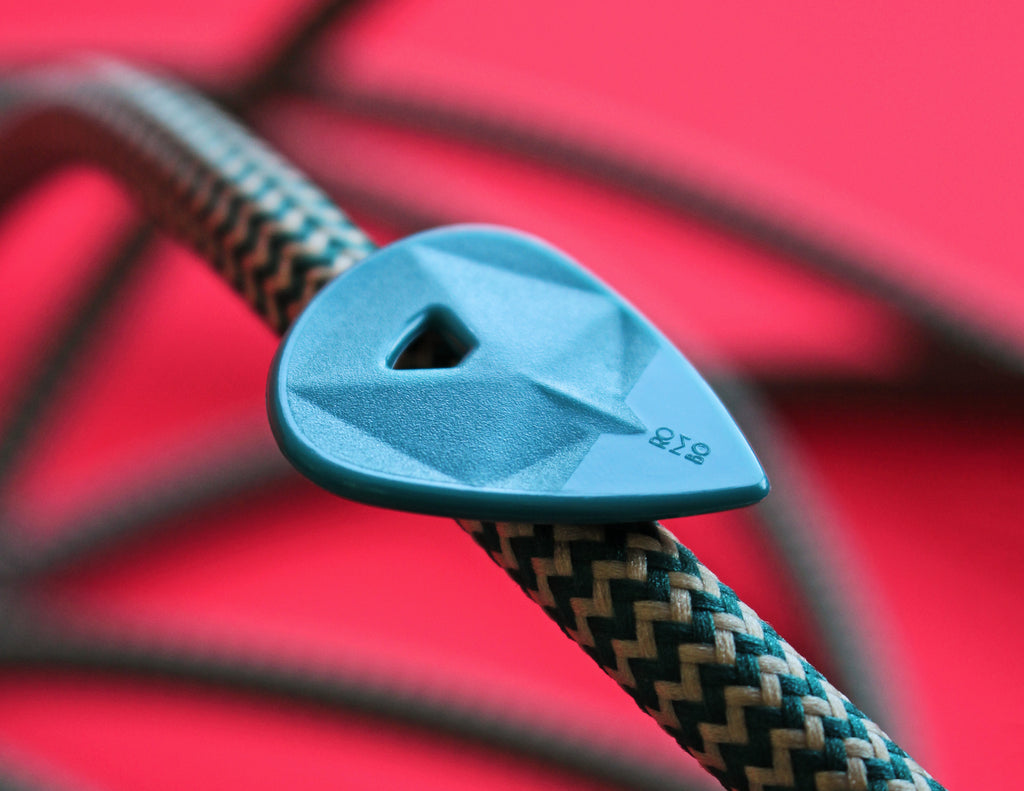
New vs. Old (worn down) Guitar Picks: Tone Changes
We all know that using different guitar picks, will also make a difference in your tone, and your playing. Material, shape, thickness and shape of the pick, directly affect the tone and playability.
Most standard plectrums can resist heavy strumming for a long time, without much wear and tear.
The first thing you may notice after using a guitar pick for some weeks, is that the tip is not as pointy as the new guitar pick. You will see it, and you will hear it, because the tone of the pick will change over time, with wear.


The rounded shape of the worn down plectrum, will create warmer tones, and feel darker. This is totally fine, if this is the tone you are looking for.
It will also affect the way your plectrum plucks the strings:

Just like the guitar strings, the frets, & other components, the guitar picks will wear out over time.
Some players feel a lack of control after the guitar pick has worn down, while others use the rounder picks because of the tone they produce. This especially happens to jazz guitarists, who tend to choose picks that are almost circular, for example: Rombo Waves.
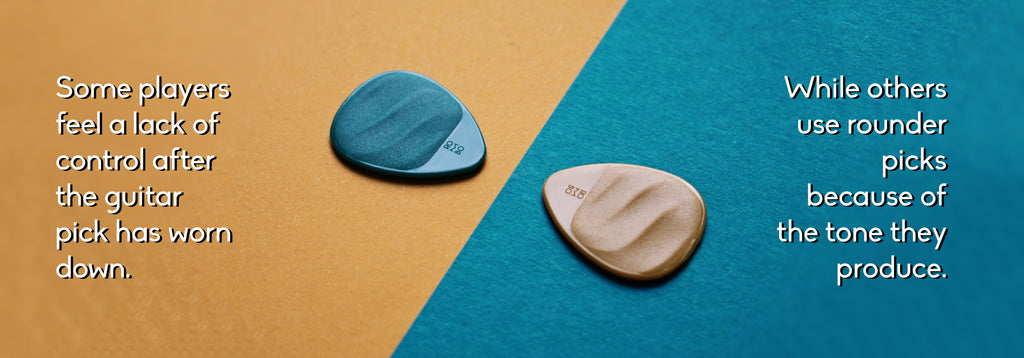
Gaining control when using rounder guitar picks, is an ability you can train yourself to do, and improve.
Why Can’t Picks Last Forever?
Guitar strings are usually made from a mix of steel, nickel, bronze, or brass. In other words: Metals.
Since most players use some kind of plastic material for their guitar picks, (nylon, delrin, …), it’s not surprising that friction between strings and picks will cause the guitar picks to wear down.
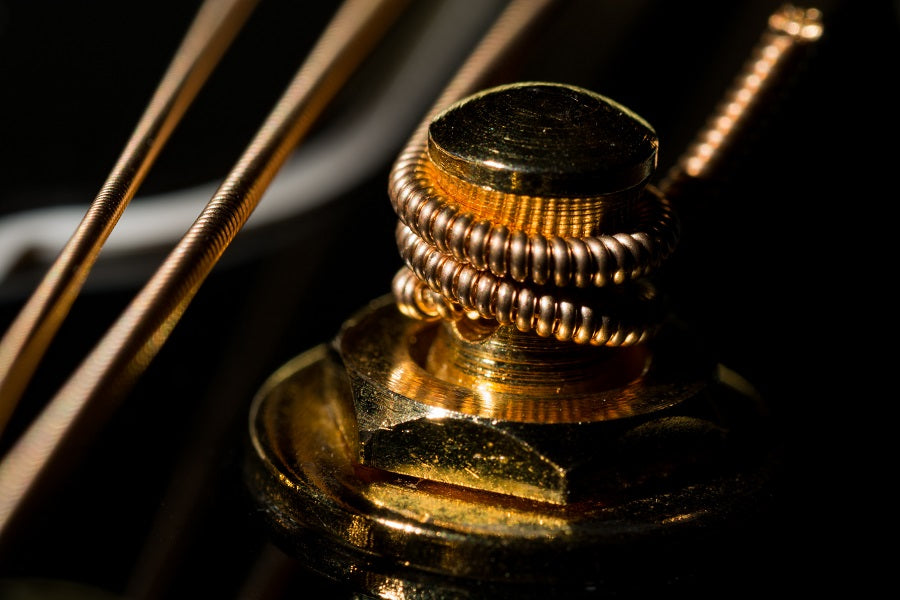
You will notice, the thickest guitar strings have a spiral wire wrapped-around, acting like a sanding file on the plectrum.
Guitar Pick Durability: How Long Should a Guitar Pick Last?
The short answer: If you are an average user, your picks should last a few weeks to a month. If you are a professional player, using specific techniques, like heavy picking and strumming, it will probably last just one day, especially if you are a studio musician recording new tracks every day.
The long answer: This answer includes many factors including guitar pick attributes, and external factors, regardless of the guitar pick you are using. We discuss all of them below.
Guitar Pick Attributes That Directly Affect the Durability
The attributes that define the durability of a guitar pick are as follows:
- Guitar Pick Material
- Guitar Pick Thickness
- Guitar Pick Tip Shape
- Guitar Pick Tip Texture
Harder materials will wear down slower. This is one of the reasons there has been a lot of research in the area of suitable materials for guitar picks.
The goal is to find a wear-resistant material, that keeps the tone characteristics that guitar players want, while still giving a good grip.
However, material is not all. The thickness of a guitar pick will enormously affect the wear and tear. Thinner picks will wear down almost immediately when using heavy pick techniques.

Other attributes of the pick that affect the durability, are the Tip Shape, and the Tip Texture. Very pointed guitar tips tend to wear down faster, because there is less material on the tip.
However, this problem can be partially solved with the right guitar pick tip texture. A polished tip on the guitar pick will cause less friction between strings and plectrum. This is one of the most underrated attributes of a guitar pick, and you can find more information HERE.
What Damages the Pick the Most?
Results show, that the best way of altering and degrading the shape of your plectrums is to perform “pick slides”.
This guitar technique will wear away the edges of your plectrum and will make it useless very quickly.
This won’t directly affect the tone or control of the plectrum, but the damaged sides will contain some dents. The plectrum will get stuck either on the up stroke or the down stroke.
External Factors Which Indirectly Affect the Durability
It’s not only the guitar pick quality that is responsible for its‘ damage. There are three more factors that can play a role on the durability:
- Hours of guitar training
- Guitar strings gauge
- Guitar playing style and used techniques
It is a very simple equation: The more hours you practice, the more your picks will get damaged.
Thicker guitar strings will increase the area of contact with your plectrum, and therefore, wear it down much faster.
Aggressive guitar playing techniques, like fast palm mute, or pick slides, will damage your guitar pick very easily.

How to know if a Pick is Durable?
The best way to find out, is to test it, and make your own judgment.
You can take advice of expert players, who have tested lots of guitar picks. However, if their playing styles differ from yours, this information won’t help much.
Besides, many expert players have not changed their picks for decades, and they might be missing the material improvements of the last decade.
As mentioned, not only is durability a factor to take into account when choosing a guitar pick, but also the tone and the ergonomics (grip, size,...).
How to Know When to Replace Your Pick?
If the edges of your pick are becoming more rounded, you might start to consider purchasing a new one.
However, never throw away your worn-down guitar picks! The rounded edges can be used to create more mellow tones, and you might want these for some of your songs.
One of the most important things about playing the guitar, is to keep your mind open to new tones and styles. This is the reason some guitar picks have rounded tips even when they are new.

In addition, you can store your old guitar picks in a box. I wish I still had my first guitar pick, that I used, when I was learned to play guitar as a child. A guitar pick can be a beautiful piece of your past.
Check Your Pick Condition Regularly
A tip from my side, is to double check every guitar pick before going out on stage, or studio. A visual inspection is fine.
Always keep some unused plectrums aside. Considering plectrums are probably the least expensive gear of your complete guitar rig, constant wear and tear issues is not a thing you should worry about.

Choose your ideal Plectrum
Are you using the right pick? This is a question you should ask yourself every time you play a song.
Some players have their 5-favourites, depending on the style and type of guitar they want to play.
The most important factors when choosing the right plectrum for you hinges on….
- Material
- Shape
- Thickness
- Size
- Playing style
- Your personal preference
We created a guide that will help you find the right plectrum for you.
You can find it HERE.
Thank you!
The support we are getting from the guitar community makes us very happy!
We, (Carlos and Judith), are really doing our best to create the best guitar picks for you.
If you consider supporting a small family start-up, you can share this article and directly have an influence on our online visibility.
These small actions have helped us since January 2019, and we count on your support! :)

Thanks!
- Shop
- Dealers
- Legal Notice
- Terms of Service
- Refund Policy
- Shipping
- Privacy Policy
- Contact us
- Press
- FAQ
Sign up to get the latest on sales, new releases and more…
By signing up you agree to our privacy policy.
© 2024 ROMBO.
registered brand
Powered by Shopify




